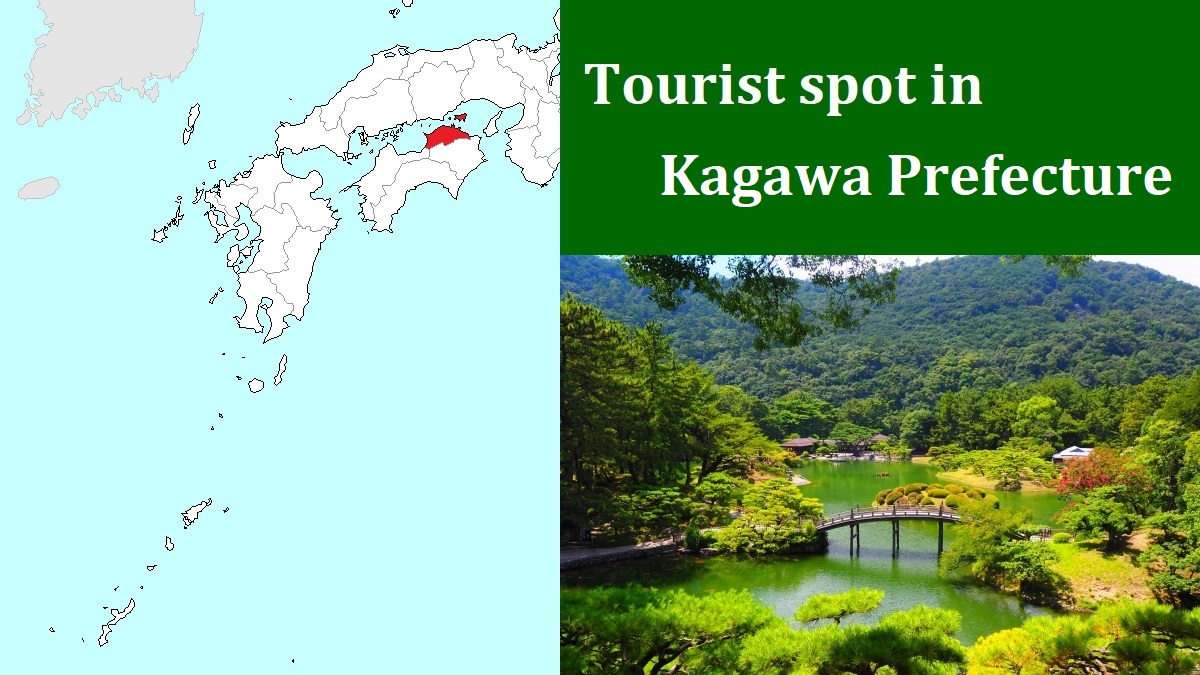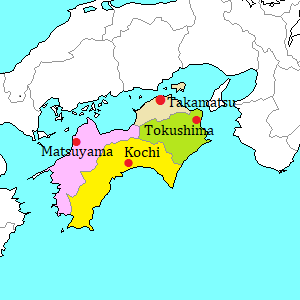Shodoshima island [小豆島]
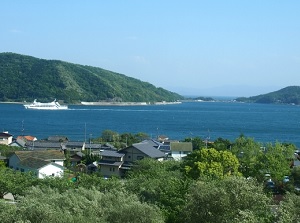
Scenery of Shodoshima
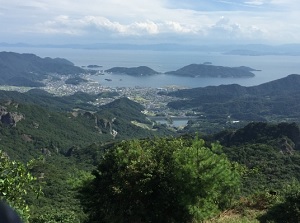
Scenery from Kankakei
Shodoshima is an island located about 20 km northeast of Takamatsu city.
The first "o" in the word is pronounced long, so it is read as "Shôdoshima".
Shodoshima is the second largest island in Seto Inland Sea (Seto Naikai) after Awaji Island.
The shape of the island is similar to a cow, and two peninsulas extend to the south like its legs.
The island is about 24 km from east to west and about 18 km from north to south in width.
The climate is mild, so plum and olive are produced.
Especially, Shodoshima is the place where olive was produced first in Japan, and the olive production in Shodoshima is still the top in Japan.
Tsuboi Sakae (1899-1967) was a woman novelist born in this island.
She published a novel "Twenty-Four Eyes" in 1952.
The story is as follows.
A first-year woman teacher came to a small elementary school in an island in the late 1920s.
She took charge of the class with 12 new students.
In the times, the people in this islands were poor.
But the teacher came from a large city, so she had always worn the smart Western dresses.
The islanders felt the gap between rich and poor, then they hated her.
But she taught the students eagerly, so the children had loved her.
One day, she suffered massive injuries on her leg and became impossible to come to the school.
So it had been decided that she was transferred to a school in a city.
The islanders finally realized that she was the person hard to replace for the children.
There was the World War II from 1941 to 1945 in Japan.
After that, the teacher and the students met again.
The teacher had married, but her husband had been killed in the war.
Also some of her students had been killed in the war.
The cruel war had damaged the lives of all of them.
This novel including antiwar message was filmed as an immortal work in 1954.
Shodoshima was used as a location site for the movie, because of the hometown of Tsuboi Sakae and suggesting the island in her novel.
By the movie, Shodoshima island became known all over Japan.
In this island, there are some spots associated with "Twenty-Four Eyes".
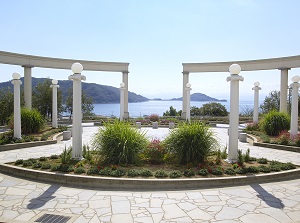
Olive Park in Shodoshima
Photo by Kagawa Prefecture
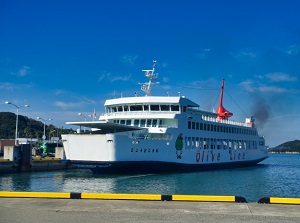
Tonosho Port
To visit Shodoshima, ferry is used.
The main port is in Tonosho (土庄) district on the western coast, and the ferries come from Takamatsu, Uno and Shin-Okayama Ports.
There is another port in Fukuda (福田) district on the eastern coast, and the ferries come from Himeji Port.
In the island, route bus is operated every several tens minutes to an hour.
We can visit the most sightseeing spots by the bus.
And the regular tour bus visiting some major spots is operated every day.
The point of departure is Tonosho.
Tonosho district (土庄)
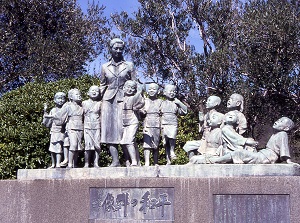
Heiwa no Gunzo
Photo by Kagawa Prefecture
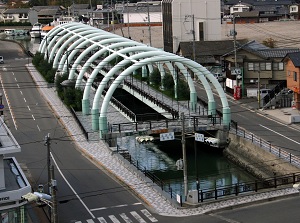
Dobuchi Strait
Photo by Kagawa Prefecture
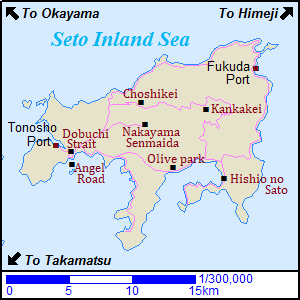
Tonosho is the base place to travel around Shodoshima.
There is a ferry port and most route buses starts from the port.
There is Heiwa no Gunzo (平和の群像) near the port.
It is a group statue of a woman teacher and 12 students in "Twenty-Four Eyes" and is the symbol of Shodoshima.
It was unveiled in 1956.
The nameplate was written by Hatoyama Ichiro, the Prime Minister at the time.
Tonosho Port is in Dobuchi Strait (土渕海峡).
The strait is the narrowest in the world and is in the Guinness Book of World Records.
The length is about 2.5 km, and the width is only 9.93 meters at the narrowest point.
It runs through the town of Tonosho town, and it looks like an ordinary canal.
The narrowest point is in the center of the town and is located about 1.3 km east of the port.
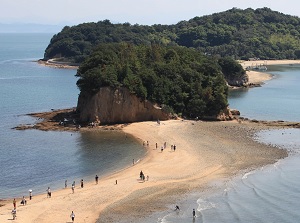
Angel Road
Photo by Kagawa Prefecture
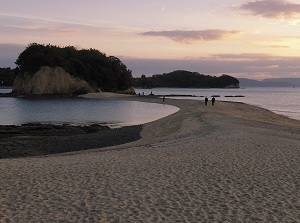
Angel Road in the evening
Photo by Kagawa Prefecture
There is a narrow sandbar which appears only twice a day at low tide.
It is located about 1.5 km south of the center of the town, and is called Angel Road.
The sandbar is about 500 meters and a small island is connected by the sandbar.
"If you hold the hand of your lover on the middle of sandbar, the angel makes your wishes come true."
This rumor has been spread by word of mouth, so Angel Road is the popular spot for couples.
Shodoshima Olive Park
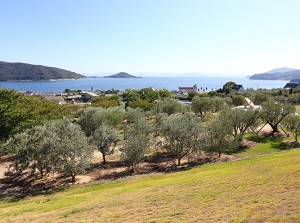
Shodoshima Olive Park
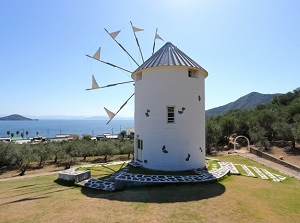
Greek wind mill in Olive Park
Shodoshima Olive Park is located about 11 km east of Tonosho district.
The park is surrounding with olive gardens.
There are the museum about olive, shops, restaurant and cafe.
A Greek wind mill in the park has been given by Milos Island in Greece which is Shodoshima's sister island.
"Kiki's Delivery Service" is a popular Studio Ghibli anime film in 1989, and its live-action film was created in 2014.
At that time, this park and the wind mill was used as a shooting place for the film.
It takes about 30 minutes from Tonosho Port by route bus.
Hishio no Sato (醤の郷)
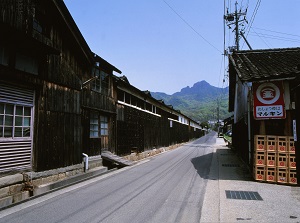
Hishio no Sato
Photo by Kagawa Prefecture
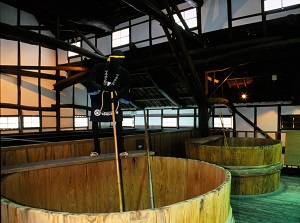
Marukin Soy Sauce Museum
Photo by Kagawa Prefecture
Hishio no Sato is a historic district of soy-sauce breweries.
It is located on the eastern edge of the bay and is about 6 km from Olive Park.
The climate of Shodoshima is suitable for producing soy sauce (shoyu), so soy sauce has been produced since the 17th century.
Especially, it features using traditional big wooden buckets to brew.
There are about 20 soy-sauce breweries in the area of 1 km in Umaki (馬木) and Nouma (苗羽) districts.
In some breweries, the visitors can observe the production process.
Marukin Soy Sauce Museum (マルキン醤油記念館) is a museum introducing the history of Marukin Brewery and the process producing soy sauce.
The building is the former brewery.
It takes about 45 minutes from Tonosho Port to Umaki, Nouma, or Marukin-mae stop by route bus.
Kankakei gorge (寒霞渓)
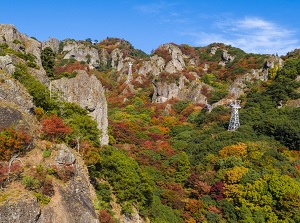
Kankakei gorge
Photo by Kagawa Prefecture
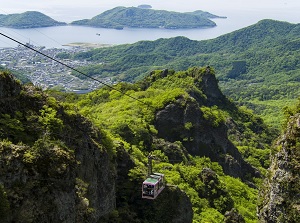
Kankakei ropeway
Photo by Kagawa Prefecture

Kankakei is a gorge in the center of the island.
It is around Mount Hoshigajo (817 m), and there are steep cliffs and rock walls.
It is the most popular scenic area in shodoshima, and particularly, this area in foliage season is very wonderful.
We can go up to the observatory by ropeway.
By route bus, it takes about 35 minutes from Tonosho Port to Kusakabe-ko stop.
From Kusakabe-ko, it takes 14 minutes to Ko-untei stop.
From there, you can get on the ropeway.
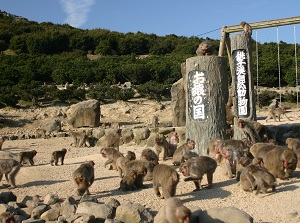
Monkey Park in Choshikei
Photo by Kagawa Prefecture
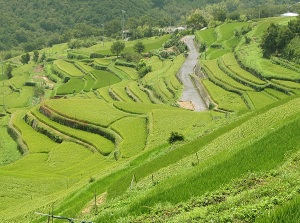
Nakayama Rice Terrace
Photo by Kagawa Prefecture
Chôshikei gorge (銚子渓)
Chôshikei is a gorge located about 7 km west of Kankakei.
There is a waterfall about 21 meters high.
But, Monkey Park around the gorge is popular.
About 500 monkeys which have been fed by hand are in the natural zoo.
The route bus to this gorge is not operated.
So, visitors must use a regular tour bus or a rental car.
Nakayama Rice Terrace (中山千枚田)
Nakayama Rice Terrace ("Nakayama Senmaida" in Japanese) is a scenic rice terrace.
It is located about 8 km northeast of the center of Tonosho.
It is on the slope of the mountainside at an altitude of 200 to 300 meters above sea level.
Over 800 small rice fields are arranged in a staircase pattern.
Clear spring water comes out around the rice terrace, and there is the bountiful forests around the rice terrace.
By route bus, it takes about 23 minutes from Tonosho Port to Oku-Nakayama stop.
How to get here
From Takamatsu Port to Tonosho Port, about 30 minutes by high-speed ship.
about 60 to 65 minutes by ferry.
From Uno Port to Tonosho Port, about 1 hour and 30 minutes by ferry.
From Shin-Okayama Port to Tonosho Port, about 1 hour and 10 minutes by ferry.
To Shin-Okayama Port, by route bus, about 35 minutes from JR Okayama station.
From Himeji Port to Fukuda Port, about 40 minutes by ferry.

